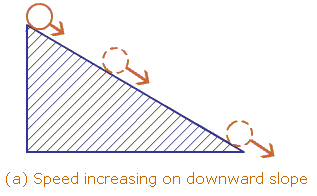It is impossible not to conserve energy because energy is always conserved. This is a fundamental principle of physics. There are three parts to the Law of Conservation of Energy including: energy, momentum, and angular momentum. What is energy? Energy is observed in many shapes and forms on earth and the universe. However, if energy is always conserved how do objects get started?
W = Fh
Weight = Force x Height
If the object is near earth then W = mgh due to the force of gravity.
Therefore U = mgh or potential energy is equivalent to the "work put into it," where potential energy depends on vertical distance. Take an inclined plane for example:
The potential energy of the object depends on the height of the inclined plane. In a system with two adjacent inclined planes without any other external forces exerted on the object, the object would travel down the inclined plane where potential energy would change into kinetic energy, and then change into potential energy as it reaches the same initial height on the second inclined plane.
dW = Fdx
W = integral (Fdx)
If work is done against a constant opposing force, as in lifting a block from one height to another then:
h1
W = F x integral (dx)
h0
h1
= Fx |
h0
= Fh1 - Fh0
U = Fh
W = U1 - U2
The work is the difference between the potential energy at the two heights or the change in potential energy.
If work is done with no opposing force, then the force is still work integrated over disance where:
x1
W = integral (Fdx)
x0
however the result of the work is to accelerate the block, therefore it gains speed. If the interval is considered in terms of speed:
W = integral (madx) F = ma
W = integral (m (dv/dt) dx)
= integral (m (dx/dt) dv)
= integral (mvdv)
v1
W = m (integral (v) dv)
v0
v1
= m 1/2 v^2 |
v0
2 2
W = 1/2 m v - 1/2 m v
1 0
Therefore work is the change in the quantity k = 1/2 m v^2 or kinetic energy, the energy of motion.
Potential energy changes constantly while kinetic energy is constantly in flux. When the sum of both is considered, the totality of energy is a constant:
E = U + K
energy = potential energy + kinetic energy
= constant
The transfer of potential and kinetic energy can be observed in the following video:
James Joule is credited with the discovery of the conservation of energy by studying how much mechanical energy turns into heat as a large weight is lifted to a certain height. This has a precise potential energy:
U = mgh
Joule arranged to have falling weights turn paddle wheels in an insulated container of water. Joules then measured the water's temperature, given the loss of potential energy always turns into precisely the same amount of heat because loss is also gain in energy. Vibrations of atoms have a number of effects by jostling air that creates soundwaves, and generates heat. Heat spreads from molecule to molecule dispersing energy but not destoying it. Energy is neither created or destroyed. Heat dispersion is merely spread into vibrations that increases potential and kinetic energy of atoms by exactly the amount that has been lost. Activity can be measured in the form of the same basic unit known as a Newton meter or 1J.
4.2 J = 1 cal, the standard measure of heat.
Energy flows throughout the universe ever changing but constant, and is not lost but transformed into heat. As energy changes forms, it becomes harder and harder to retrieve at the atomic level.
The following video explains the conservation of energy further:

No comments:
Post a Comment